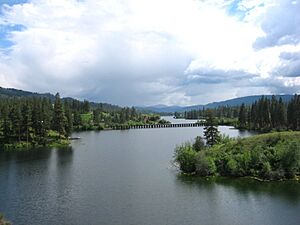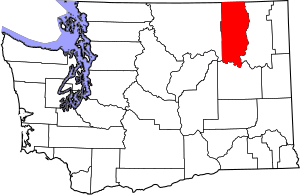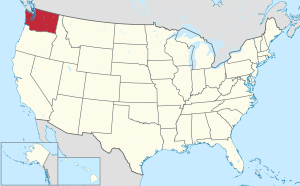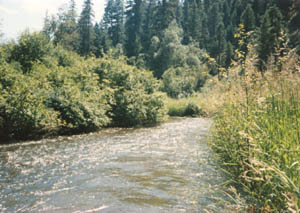Ferry County, Washington facts for kids
Quick facts for kids
Ferry County
|
|
|---|---|

Ferry County Rail Trail trestle at Curlew Lake
|
|

Location within the U.S. state of Washington
|
|
 Washington's location within the U.S. |
|
| Country | |
| State | |
| Founded | February 21, 1899 |
| Named for | Elisha P. Ferry |
| Seat | Republic |
| Largest city | Republic |
| Area | |
| • Total | 2,257 sq mi (5,850 km2) |
| • Land | 2,203 sq mi (5,710 km2) |
| • Water | 54 sq mi (140 km2) 2.4%% |
| Population
(2020)
|
|
| • Total | 7,178 |
| • Estimate
(2023)
|
7,497 |
| • Density | 3.5/sq mi (1.4/km2) |
| Time zone | UTC−8 (Pacific) |
| • Summer (DST) | UTC−7 (PDT) |
| Congressional district | 5th |
Ferry County is a county located on the northern border of the U.S. state of Washington. As of the 2020 census, the population was 7,178, making it the fourth-least populous county in Washington. The county seat and largest city is Republic. The county was created out of Stevens County in February 1899 and is named for Elisha P. Ferry, the state's first governor.
Contents
Etymology
The county was first slated by the state government to be named "Eureka County", but was revised while the bill was in discussion to "Ferry County" in recognition of the Territory's last governor and the State's first governor, Elisha P. Ferry. The change is suggested to have happened as a bookend to the naming of Stevens County, named for the first governor of Washington Territory.
History
The Territorial Legislature of Washington Territory first carved Stevens County from Walla Walla County in 1863 to encompass all the land from the Columbia River west to the Cascades and north of the Wenatchee River. On January 20, 1864, the original territorial Spokane County was dissolved and merged with the unorganized Stevens County. On February 2, 1888 the western expanse of territorial Stevens County was sectioned off by dividing the county in half along the Okanogan Highlands crest. Eleven years later, on February 18, 1899, the western section of Stevens County was again sectioned off, this time along the Columbia, to form Ferry County.
The town of Republic is the county's seat of government, as well as the largest town. It was founded at the end of the nineteenth century by gold prospectors and was incorporated in 1900. The original election precinct of Republic was created on April 6, 1898. Following the 1922 primary elections, a group of citizens called for an investigation into possible election irregularities. The group claimed that two of that years voting precincts had been formed unlawfully in conjunction with misconduct in six precincts by election officers and the canvassing board. As a result of the actions, the validity of two candidates were called in question. Demands were made that Thomas F. Barker, seeking re-election as sheriff, and John W. McCool, seeking the County Treasurer seat, be barred from the ballot. Barker was notably facing charges at the federal level at that time from allegations of conspiring and abetting bootleggers.
The original county courthouse, made of wood, burned in 1934. Its replacement, made of concrete and stucco, was under consideration beginning in 2018 for historical preservation.
On August 13, 2001, a series of major wildfires and complexes were ignited by regional lightning storms passing over eastern Washington. Among them was the Mount Leona Fire which burned for several weeks and encompassed over 6,000 acres in the central Kettle River range northeast of Curlew Lake.
Geography
Ferry County is bordered on the north by the Kootenay Boundary Regional District, British Columbia, Canada, along the 49th parallel; to the west by Okanogan County along the boundary between ranges 31 and 32 east; to the south by Lincoln County in the midline of the Columbia River; and on the east by Stevens County, again along the Columbia River and then Kettle River midlines. According to the United States Census Bureau, the county has a total area of 2,257 square miles (5,850 km2), of which 2,203 square miles (5,710 km2) is land and 54 square miles (140 km2) (2.4%) is water. Most of Ferry County is covered by the rugged Kettle River Range, which extends from the Canada–US border to its southernmost perimeter bounded by the Columbia River and Roosevelt Lake. Only a narrow north–south strip running the length of the county on the west between the Sanpoil River and the Okanogan County line encompasses part of the Okanogan Highland. Except for the town of Republic, the county is sparsely populated.
The county has three major river systems, with the impounded Columbia Rivers Franklin D. Roosevelt Lake forming the southern and most of the eastern county boundary. Along the northern border, the Kettle River drops south into the county near the Midway, British Columbia border crossing, before turning north again at Curlew to cross into Canada at the Danville border crossing. It swings south again on the eastern side of the Kettle River Range and passes into the US just east of the Lauier border crossing and is the northern section of the Ferry-Stevens county Border before joining with the Columbia River north of Barney's Junction. The southern and south central part of the county from just south of Curlew Lake is all drained by the south flowing Sanpoil River, which joins Franklin D. Roosevelt Lake at the southern tip of the county south of Keller. Southwest of Republic in the eastern edge of the Okanogan highlands is a group of four recreational lakes, Swan Lake, Ferry Lake, Fish Lake, and Long Lake in Colville National Forest land, while the Lake Roosevelt National Recreation Area is accessible on the eastern edges of the county.
Kettle River Peaks
The highest peaks in the county are located along the crest of the Kettle River Range and are part of either the Colville National Forest or the Colville Indian Reservation. Highway 20 crosses over the Kettle River Range along the southern shoulder of Sherman Peak at Sherman Pass, which at 5,575 feet (1,699 m) is highest mountain pass open all year in the state. Crossing the county east to west is the Pacific Northwest National Scenic Trail, which enters the county along the Boulder pass highway, turns south along the Kettle Crest National Recreation Trail and turns west again along the 13 mile trail.
- Copper Butte, highest point: 7,140 feet (2,176 m)
- Snow Peak, 7,103 feet (2,165 m)
- Scar Mountain, 7,046 feet (2,148 m)
- Wapaloosie Mountain, 7,018 feet (2,139 m)
- Sherman Peak, 7,011 feet (2,137 m)
- Bald Mountain, 6,940 feet (2,115 m)
- White Mountain, 6,923 feet (2,110 m)
- Columbia Mountain, 6,782 feet (2,067 m)
- Midnight Mountain, 6,660 feet (2,030 m)
- King Mountain, 6,634 feet (2,022 m)
- Edds Mountain, 6,540 feet (1,993 m)
Economy
Ferry County reaches to Canada on the north, and to the Columbia River on the east. Its southern portion is in the boundary of the Colville Indian Reservation, controlled by the Colville Confederated Tribes, and its northern portion is largely occupied by Colville National Forest. As a result, only eighteen percent of the total county area is taxable-use ground. The county's economy is largely based on timber-extraction, and mining.
Ferry County's topography and climate make it an ideal recreation destination, so tourism has become a significant portion of the county's economy. Washington State Highway 20, designated a National Scenic Highway, crosses the county east–west, and has the state's highest navigable pass (5,575 feet above sea level).
The county seat, Republic, is the site of the Stonerose Interpretive Center and Fossil Site, which exhibits and explains Eocene-era fossils from an ancient lake bed north of Republic. Anderson's Grocery is the main grocery of northern Ferry County, having been in operation since 1900, and never burning down.
Demographics
| Historical population | |||
|---|---|---|---|
| Census | Pop. | %± | |
| 1900 | 4,562 | — | |
| 1910 | 4,800 | 5.2% | |
| 1920 | 5,143 | 7.1% | |
| 1930 | 4,292 | −16.5% | |
| 1940 | 4,701 | 9.5% | |
| 1950 | 4,096 | −12.9% | |
| 1960 | 3,889 | −5.1% | |
| 1970 | 3,655 | −6.0% | |
| 1980 | 5,811 | 59.0% | |
| 1990 | 6,295 | 8.3% | |
| 2000 | 7,260 | 15.3% | |
| 2010 | 7,551 | 4.0% | |
| 2020 | 7,178 | −4.9% | |
| 2023 (est.) | 7,497 | −0.7% | |
| U.S. Decennial Census 1790–1960 1900–1990 1990–2000 2010–2020 |
|||
2010 census
As of the 2010 census, there were 7,551 people, 3,190 households, and 2,070 families living in the county. The population density was 3.4 inhabitants per square mile (1.3/km2). There were 4,403 housing units at an average density of 2.0 per square mile (0.77/km2). The racial makeup of the county was 76.3% white, 16.7% American Indian, 0.7% Asian, 0.3% black or African American, 0.1% Pacific islander, 1.2% from other races, and 4.8% from two or more races. Those of Hispanic or Latino origin made up 3.4% of the population. In terms of ancestry, 23.0% were German, 18.0% were English, 12.3% were Irish, and 3.7% were American.
Of the 3,190 households, 23.9% had children under the age of 18 living with them, 49.2% were married couples living together, 9.2% had a female householder with no husband present, 35.1% were non-families, and 28.5% of all households were made up of individuals. The average household size was 2.29 and the average family size was 2.75. The median age was 47.3 years.
The median income for a household in the county was $35,485 and the median income for a family was $43,576. Males had a median income of $41,755 versus $30,972 for females. The per capita income for the county was $18,021. About 13.6% of families and 20.8% of the population were below the poverty line, including 24.3% of those under age 18 and 12.4% of those age 65 or over.
Communities
City
- Republic (county seat)
Census-designated places
Other unincorporated communities
Notable people
- Alex N. Dragnich (1912-2009) - political scientist
- Stella Leach (1918-2010) - nurse and activist
See also
 In Spanish: Condado de Ferry para niños
In Spanish: Condado de Ferry para niños



